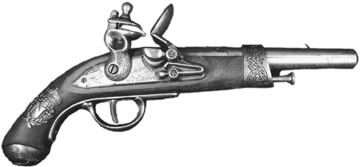The outdated weapon that we can’t stop talking about.

The flintlock was invented in France in 1610 and came to American shores shortly thereafter. For more than 200 years, the flintlock played a major role in American history. Flintlock muskets and pistols were the weapons of choice in the American Revolution, the War of 1812, and the Civil War.
And though they have been obsolete for more than a century, they live on in our language.
To fire a flintlock, the shooter first cocked the hammer partway so that he could sprinkle some powder onto the priming pan—but he had to remember to cock the hammer the rest of way before firing. Otherwise the gun would go off half-cocked.
When the trigger was pulled, the hammer brought down a piece of flint with great force, creating a shower of sparks. If the powder in the pan ignited but failed to set off the charge inside the barrel, the result was a showy but useless flash in the pan.
When that happened, no one knew when or if the gun was going to go off. It was said to be hanging fire.
By the way, the “lock” in flintlock referred to the firing mechanism. It was one of three major parts of the gun: only if you had the lock, stock, and barrel did you have everything.
Remember the flintlock!

The most famous flintlock was the “Brown Bess,” used by British soldiers for more than a century, and eventually immortalized by Rudyard Kipling:

It was a flintlock rifle that fired the “shot heard round the world” on April 19, 1775, that began the American Revolution.
Brown Bess was a partner whom none could despise . . .
With a habit of looking men straight in the eyes.
At Blenheim and Ramillies, fops would confess They were pierced to the heart by the charms of Brown Bess.